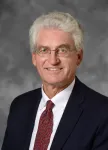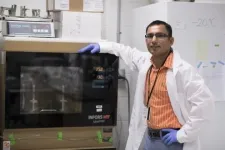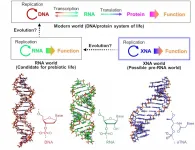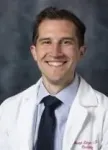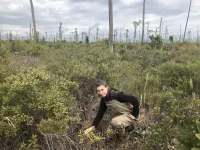(Press-News.org) Making the Case for Adjusting Quality Measures for Social Risk Factors
Henry Ford Health System-led report says adjustments would enhance quality.
DETROIT (April 5, 2021) - A new analysis by a team of researchers led by Dr. David Nerenz of Henry Ford Health System suggests that accounting for social risk factors like poverty, housing instability and transportation insecurity can have meaningful impact on healthcare quality measures without compromising quality of care.
In a report published today in Health Affairs, researchers make the case for using social risk factors in specific circumstances to "level the playing field" for adjusting quality measures used in quality reporting and value-based purchasing programs. Social risk adjustment would apply to scenarios in which providers cannot mitigate the impact of social risk factors and when those risk factors directly impact care outcomes.
"We acknowledge the challenges in knowing when social risk adjustment is appropriate, but we have shown when it should be done and not done," said David Nerenz, Ph.D., Director Emeritus of Henry Ford's Center for Policy and Health Services Research and the study's lead author.
"In our analysis we show that adjusting for social risk factors will not necessarily mask or excuse poor quality. Instead, it can demonstrate exceptional levels of quality among safety-net providers."
Adjusting quality measures for social risk factors has been the focus of ongoing debate for the last decade since the Medicare Hospital Readmission Reduction Program (HRRP) was shown to disproportionately penalize safety-net hospitals financially. Safety net hospitals have long held they are unfairly penalized because social risk factors put their patients at higher risk for readmission and are not adjusted for in HRRP.
In 2014, an expert panel convened by the National Quality Forum recommended using social risk factors under certain circumstances. However, the Assistant Secretary of Planning and Evaluation, the principal advisor to the secretary of the U.S. Department of Health and Human Services, issued a report in June 2020 opposing adjustments for social risk factors.
"This has been a contentious issue, but there is growing consensus that social risk matters," said
Karen Joynt Maddox, M.D., MPH, a co-author of the Health Affairs report and Assistant Professor of Medicine in the Cardiovascular Division at Washington University's School of Medicine in Missouri.
"To move towards high-value care that improves the health of populations, equity has to be central rather than an afterthought. We this analysis moves the needle on making that happen."
Dr. Nerenz and Dr. Maddox led a study published in Health Services Research in 2019 that found a risk adjustment model including social factors could reduce the financial penalty for at least half of all safety-net hospitals, which care for patients regardless of their insurance status or ability to pay. In some cases, the study said, the adjustment model could render them free from any penalty.
Conversely, more affluent hospitals - those that care for higher-income, better-educated patients - could see their penalty for readmission rates increase.
Quality measures like mortality rates, readmission rates, complication rates, and average functional improvement are used to compare doctors, hospitals, home health agencies, and health plans. These measures are then applied to determine financial rewards and penalties for providers that perform relatively well or poorly.
Because providers don't treat the same mix of patients, and some patients are at higher or lower risk of poor outcome than others, some form of statistical adjustment is applied to level of the playing field for making comparisons, Dr. Nerenz said.
"While clinical risk factors like age, presence of other illnesses, and severity of illness are used routinely in these adjustments, social risk factors have not," Dr. Nerenz said. "At issue is whether the financial penalties reflect true differences in quality of care, or they reflect factors other than quality that are outside of providers' control."
INFORMATION:
About Henry Ford Health System
Founded in 1915 by Henry Ford himself, Henry Ford Health System is a non-profit, integrated health system committed to improving people's lives through excellence in the science and art of healthcare and healing. Henry Ford Health System includes Henry Ford Medical Group, with more than 1,900 physicians and researchers practicing in more than 50 specialties at locations throughout Southeast and Central Michigan. Acute care hospitals include Henry Ford Hospital in Detroit, MI and Henry Ford Allegiance Health in Jackson, MI - both Magnet® hospitals; Henry Ford Macomb Hospital; Henry Ford West Bloomfield Hospital; and Henry Ford Wyandotte Hospital.
The largest of these is Henry Ford Hospital in Detroit, a quaternary care research and teaching hospital and Level 1 Trauma Center recognized for clinical excellence in cardiology, cardiovascular surgery, neurology, neurosurgery, and multi-organ transplants. The health system also provides comprehensive, best-in-class care for cancer at the Brigitte Harris Cancer Pavilion, and orthopedics and sports medicine at the William Clay Ford Center for Athletic Medicine - both in Detroit.
As one of the nation's leading academic medical centers, Henry Ford Health System annually trains more than 3,000 medical students, residents, and fellows in more than 50 accredited programs, and has trained nearly 40% of the state's physicians. Our dedication to education and research is supported by nearly $100 million in annual grants from the National Institutes of Health and other public and private foundations.
Henry Ford's not-for-profit health plan, Health Alliance Plan (HAP), provides health coverage for more than 540,000 people.
Henry Ford Health System employs more than 33,000 people, including more than 1,600 physicians, more than 6,600 nurses and 5,000 allied health professionals.
MEDIA CONTACTS: David Olejarz / David.Olejarz@hfhs.org / 313-303-0606
Diane Duke Williams / Williamsdia@wustl.edu / 314-286-0111
CORVALLIS, Ore. - At a time when lumber prices are skyrocketing, an Oregon State University researcher has developed a new way to predict the future price of logs that uses readily accessible economic information.
"Log prices are really variable," said Jeff Reimer, a professor of applied economics at Oregon State. "That makes this a difficult business, whether you are land manager, mill owner, timberland investor or, as we are seeing now, a home builder."
The timber industry is critical to the economy of many regions of the world, including the Pacific Northwest. The health of the timber industry can be measured in various ways, including harvest levels, ...
TUCSON, Ariz., April 6, 2021 - Dry periods between rainstorms have become longer and annual rainfall has become more erratic across most of the western United States during the past 50 years, according to a new study published by the U.S. Department of Agriculture's Agricultural Research Service and the University of Arizona
Against the backdrop of steadily warming temperatures and decreasing total yearly rainfall, rain has been falling in fewer and sometimes larger storms, with longer dry intervals between. Total yearly rainfall has decreased by an average of four inches over the last half century, while the longest dry period in each year increased from 20 to 32 days across the West, explained ...
DNA sequencing has become so common, few realize how hard it is to even extract a single molecule of DNA from a biological sample.
Research led by UC Riverside is making it easier to detect and capture DNA from fluid samples such as blood using a tiny glass tube and electric current. The technique, described in the journal, Nanoscale, can also improve cancer diagnosis in the future.
DNA, a double-stranded, electrically charged molecule that contains all the information an organism needs to create and organize the building blocks of life, is tightly folded within the cell nucleus. Extracting the DNA from a single cell is time consuming and impractical for many medical and scientific purposes. Fortunately, as cells die naturally, their membranes burst, releasing the contents, including ...
Bans on menthol cigarettes across Canada from 2016 to 2017 led to a significant increase in the number of smokers who attempted to quit, smokers who quit successfully, and lower rates of relapse among former smokers, according to a new research study from the International Tobacco Control Policy Evaluation Project (the ITC Project) at the University of Waterloo.
Menthol is the most common flavoring for cigarettes in many countries. Menthol creates a cooling sensation, which reduces the harshness of cigarette smoke. Because of this, menthol leads to increased experimentation and progression ...
New research from UVA Cancer Center could rescue once-promising immunotherapies for treating solid cancer tumors, such as ovarian, colon and triple-negative breast cancer, that ultimately failed in human clinical trials.
The research from Jogender Tushir-Singh, PhD, explains why the antibody approaches effectively killed cancer tumors in lab tests but proved ineffective in people. He found that the approaches had an unintended effect on the human immune system that potentially disabled the immune response they sought to enhance.
The new findings allowed Tushir-Singh to increase the approaches' effectiveness significantly in lab models, reducing tumor size and improving overall survival. The promising results suggest the renewed potential for the strategies in human patients, he and his ...
Seafood is a pillar of global food security--long recognized for its protein content. But research is highlighting a critical new link between the biodiversity of aquatic ecosystems and the micronutrient-rich seafood diets that help combat micronutrient deficiencies, or 'hidden hunger', in vulnerable populations.
"Getting the most nutritional value per gram of seafood is crucial in fighting hidden hunger and meeting United Nations Sustainable Development Goals," says Dr. Joey Bernhardt, an ecologist from the University of British Columbia (UBC) who led the study, published this week in the Proceedings of the National ...
Nagoya University scientists in Japan have demonstrated how DNA-like molecules could have come together as a precursor to the origins of life. The findings, published in the journal Nature Communications, not only suggest how life might have begun, but also have implications for the development of artificial life and biotechnology applications.
"The RNA world is widely thought to be a stage in the origin of life," says Nagoya University biomolecular engineer Keiji Murayama. "Before this stage, the pre-RNA world may have been based on molecules called xeno nucleic acids ...
Tsukuba, Japan - Many life forms use light as an important biological signal, including animals with visual and non-visual systems. But now, researchers from Japan have found that neuronal cells may have initially evolved to regulate digestion according to light information.
In a study published this month in BMC Biology, researchers from the University of Tsukuba have revealed that sea urchins use light to regulate the opening and closing of the pylorus, which is an important component of the digestive tract.
Light-dependent systems often rely on the activity of proteins in the Opsin family, and these are found across the animal kingdom, including in organisms with visual and non-visual systems. Understanding ...
LOS ANGELES (April 5, 2021) -- New research from the Smidt Heart Institute shows that more patients--specifically those with medical risk factors or from underserved communities--opted into telehealth appointments for their cardiovascular care during the COVID-19 pandemic. The data also suggests these telehealth patients underwent fewer diagnostic tests and received fewer medications than patients who saw their doctors in person.
The findings, published in JAMA (Journal of the American Medical Association) Network Open, point to "digital shifts" in cardiovascular care amid the ongoing COVID-19 pandemic.
"We were encouraged to learn that access to cardiovascular ...
DURHAM, N.C. -- Emily Ury remembers the first time she saw them. She was heading east from Columbia, North Carolina, on the flat, low-lying stretch of U.S. Highway 64 toward the Outer Banks. Sticking out of the marsh on one side of the road were not one but hundreds dead trees and stumps, the relic of a once-healthy forest that had been overrun by the inland creep of seawater.
"I was like, 'Whoa.' No leaves; no branches. The trees were literally just trunks. As far as the eye could see," said Ury, who recently earned a biology Ph.D. at Duke University working with professors Emily Bernhardt and Justin Wright.
In bottomlands throughout the U.S. East ...
